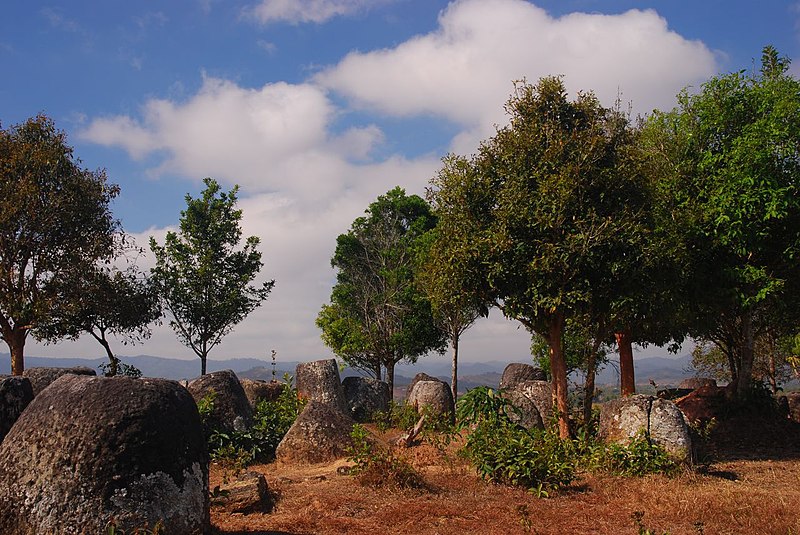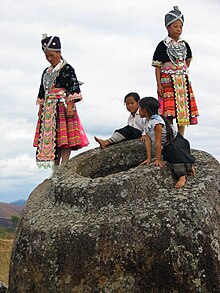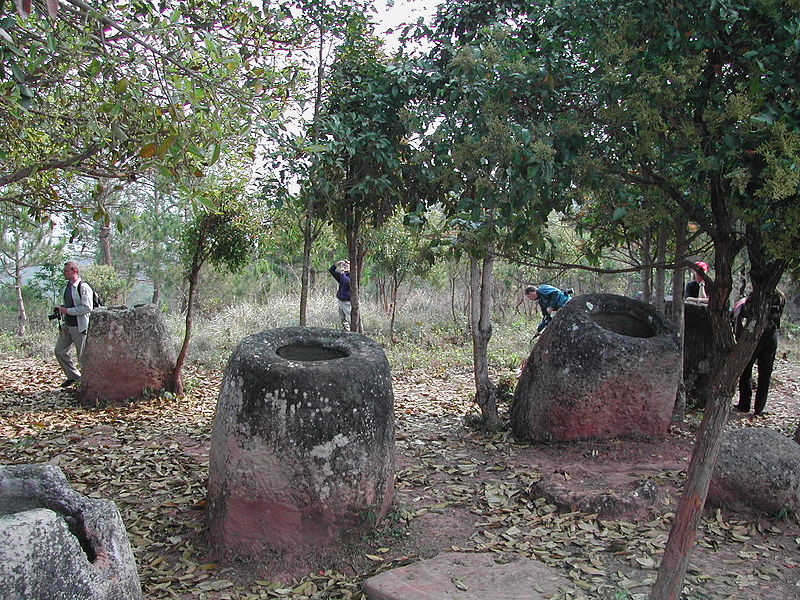The Plain of Jars (Lao: ton hai hin) is a megalithic archaeological landscape in Laos. Scattered in the landscape of the Xieng Khouang plateau Xieng Khouang, Lao PDR are thousands of megalithic jars. These stone jars appear in clusters, ranging from a single or a few to several hundred jars at lower foothills surrounding the central plain and upland valleys. The Xieng Khouang Plateau is located at the northern end of the Annamese Cordillera, the principal mountain range of Indochina. Initial research of the Plain of Jars in the early 1930s suggested that the stone jars are associated with prehistoric burial practices. Excavation by Lao and Japanese archaeologists in the intervening years has supported this interpretation with the discovery of human remains, burial goods and ceramics around the stone jars. The Plain of Jars is dated to the Iron Age (500 BCE to 500 CE) and is one of the most fascinating and important sites for studying Southeast Asian prehistory. The Plain of Jars has the potential to shed light on the relationship between increasingly complex societies and megalithic structures and provide insight into social organisation of Iron Age Southeast Asia’s communities. To visit the jar sites one would typically stay in Phonsavan.
The jar sites
More than 90 sites are known within the province of Xieng Khouang. Each site ranges from 1 up to 400 stone jars. The jars vary in height and diameter between 1 and 3 metres and are all without exception hewn out of rock. The stone jars are undecorated with the exception of a single jar at Site 1. This jar has a human bas-relief carved on the exterior. Parallels between this ‘frogman’ at Site 1 and the rock painting at Huashan in Guanxi, China have been drawn. The paintings which depict large full-frontal humans with arms raised and knees bent, are dated to 500 BCE - 200 CE .
From the fact that most of the jars have lip rims, it is presumed that all stone jars supported lids, although few stone lids have been recorded; this may suggest that the bulk of lids have been fashioned from perishable materials. Stone lids with animal representations have been noticed at few sites such as Ban Phakeo (Site 52). The bas-relief animals are thought to be monkeys, tigers and frogs. No in situ lid has ever been found.
The jars lie in clusters on the lower footslopes and mountain ridges of the hills surrounding the central plateau and upland valleys. Several quarry sites have been recorded usually close to the jar sites. Five rock types are known:sandstone, granite, conglomerate, limestone and breccia. The majority of the jars are sandstone and have been manufactured with a degree of knowledge of what materials and techniques were suitable. It is assumed that Plain of Jars' people used iron chisels to manufacture the jars although no conclusive evidence for this exists. Regional differences in jar shape have been noted. While these differences in most cases can be attributed to choice and manipulation of rock source, form differences, such as small apertures and apertures on both ends (double holed jars) which would affect the use of the jar have been recorded in one district only.
The cave at Site 1 is a natural limestone cave with an opening to the northwest and two man-made holes at the top of the cave. These holes are interpreted as chimneys of the crematorium. The French geologist and amateur archaeologist Madeleine Colani excavated in side the cave in the early 1930 and found archaeological material to support a centralized crematorium theory. Colani also recorded and excavated at 12 Plain of Jar's sites and published two volumes with her findings in 1935. The material findings and context led her to the interpretation of the Plain of Jars as an Iron Age burial site. Inside the jars, she found embedded in black organic soil coloured glass beads, burnt teeth and bone fragments, sometimes from more than one individual. Around the stone jars, she found human bone, pottery fragments, iron and bronze objects, glass and stone beads, ceramic weights and charcoal. The bone and teeth inside the stone jars show signs of cremation, while the burials surrounding the jars yield unburnt secondary burial bones.
 The suggestion that stone jars in a similar fashion as traditional Southeast Asian Royal mortuary practices functioned as 'distilling vessels' was put forward by R. Engelhardt and P. Rogers in 2001. In contemporary funerary practices connected to Thai, Cambodian and Laotian royalty the corpse of the deceased during the early stages of the funeral rites is placed into an urn, while the deceased is undergoing gradual transformation from the earthly to the spiritual world. The ritual decomposition is followed by cremation and secondary burial. The royal burials are located across watercourses from the habitation areas in a geographically high, prominent area. Meanwhile it is interesting to note that amongst the Black Tai people who have been in the region for at least since the 11th century, the elite are cremated releasing their spirit to heaven, while commoners are buried, leaving their spirit to remain on earth.
The suggestion that stone jars in a similar fashion as traditional Southeast Asian Royal mortuary practices functioned as 'distilling vessels' was put forward by R. Engelhardt and P. Rogers in 2001. In contemporary funerary practices connected to Thai, Cambodian and Laotian royalty the corpse of the deceased during the early stages of the funeral rites is placed into an urn, while the deceased is undergoing gradual transformation from the earthly to the spiritual world. The ritual decomposition is followed by cremation and secondary burial. The royal burials are located across watercourses from the habitation areas in a geographically high, prominent area. Meanwhile it is interesting to note that amongst the Black Tai people who have been in the region for at least since the 11th century, the elite are cremated releasing their spirit to heaven, while commoners are buried, leaving their spirit to remain on earth.Colani connected the location of the jars sites to ancient trade routes and in particular with the salt trade. Colani assumed salt was a commodity sought after by the Plain of Jars people, bringing the traders to the Xieng Khouang Plateau. The Xieng Khouang area is rich in metallic minerals mainly due to the granite intrusions and associated hydrothermal activity. Two principal iron ore deposits exist in Lao and both are located in Xieng Khouang. The presence and locations of the numerous jar sites in Xieng Khouang may relate to trading and mining activities. History has also shown that Xieng Khouang at the northern end of the Annamite Range provides relative easy passage from the north and east to the south and west. Within the geographic setting of Xieng Khouang the jar sites may reflect a network of intercultural villages. Whereby the location of the jars are associated to long-distance overland routes which connect the Mekong basin and the Gulf of Tonkin System. The jar sites show superficial regional differences such as jar form, material and number of jars per site but share common setting characteristics such as burial practices, elevated locations and commanding views over the surrounding area.
The most investigated and visited Jar site is located close to the town of Phonsavan, and is known as Site 1. Seven jar sites however, have been cleared of UXO (unexploded bombs) and are open to visitors. These are currently most visited Site 1, 2 and 3, and Site 16 near the Old Capital Xieng Khouang, Site 23, near the big hot spring in Muang Kham, Site 25 in the largely unvisited Muang Phukoot district and Site 52, the largest known jar site to date with 392 jars near a traditional Hmong village only accessible on foot. The UXO are remnants of Secret War in Laos in the 1960s. The large quantity of UXOs (unexploded ordinances), in particular cluster munitions, in the area limits free movement. At Site 1 evidence of the war can be seen in the form of broken or displaced jars, trench systems and bomb craters.
Legends and local history
Lao stories and legends claim that there was a race of giants who once inhabited the area. Local legend tells of an ancient king called Khun Cheung, who fought a long, victorious battle against his enemy. He supposedly created the jars to brew and store huge amounts of lao lao rice wine to celebrate his victory. Some refer to local tradition that states that the jars were molded, by using natural materials such as clay, sand, sugar, and animal products in a type of stone mix. This leads the locals to believe that the cave at Site 1 was actually a kiln, and that the huge jars were fired there and are not of stone.
Another explanation for the jars' use is for collecting monsoon rainwater for the caravan travellers along their journey in a time where rain may have been only seasonal and water not readily available on the easiest foot traveled path. Rainwater could then be boiled, even if stagnant, to become potable again, a practice long understood in Eastern Eurasia. The trade caravans that were camping around these jars and could have placed beads inside jars as an offering, to accompany prayers for rain or they might simply have been lost items.
 The Laotian government is considering applying for status as a UNESCO World Heritage site for the Plain of Jars. UNESCO-Lao Safeguarding the Plain of Jars Project has been an ongoing effort by UNESCO and the Lao Government in documenting and rehabilitating of the Plain of Jars. Clearing of the UXO hazard is one of the requirements and necessities before the sites can be studied and developed for tourism. Community based involvement in the management and conservation of the jar sites has been one of the main objectives of the project and is proving to be success. Tourism pressure on the main visited sites however, is the main cause of recent damage to the stone jars.
The Laotian government is considering applying for status as a UNESCO World Heritage site for the Plain of Jars. UNESCO-Lao Safeguarding the Plain of Jars Project has been an ongoing effort by UNESCO and the Lao Government in documenting and rehabilitating of the Plain of Jars. Clearing of the UXO hazard is one of the requirements and necessities before the sites can be studied and developed for tourism. Community based involvement in the management and conservation of the jar sites has been one of the main objectives of the project and is proving to be success. Tourism pressure on the main visited sites however, is the main cause of recent damage to the stone jars.The Mines Advisory Group, a non-governmental organization, in collaboration with UNESCO and funded by the New Zealand Government (NZAID) conducted a UXO clearance phase at the three most visited sites from July 2004 until July 2005. A second phase of UXO clearance at the jar sites also funded by NZAID was undertaken in 2007; four more jar sites were made safe.
Source: http://en.wikipedia.org/wiki/Plain_of_Jars
Images: http://commons.wikimedia.org/wiki/Category:Plain_of_Jars
















0 comments:
Post a Comment